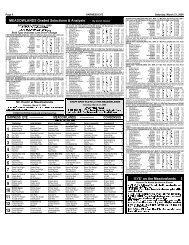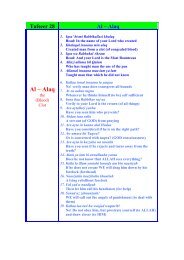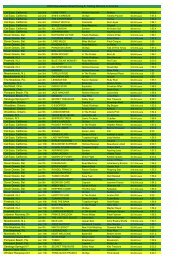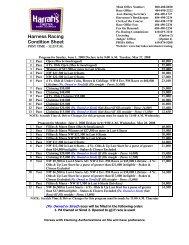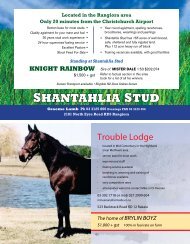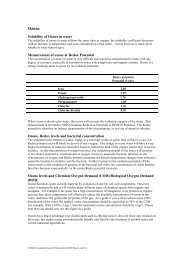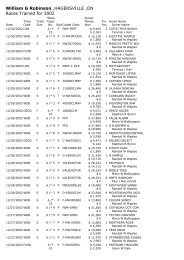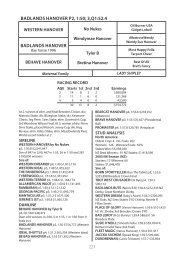Stallions - Harnesslink
Stallions - Harnesslink
Stallions - Harnesslink
You also want an ePaper? Increase the reach of your titles
YUMPU automatically turns print PDFs into web optimized ePapers that Google loves.
Controlling worms in horses - The need for change<br />
Worms in horses have generally been considered to be well controlled<br />
and not a concern to many horses owners. This general opinion has occurred<br />
because horse owners for the past 20-30 years have relied on<br />
the routine use of highly effective drenches to control the emergence<br />
of any worm problem. This approach and the drenches (chemicals)<br />
used are similar to those used in other livestock systems. Sheep and<br />
cattle farmers around the world are now having to come to terms with<br />
the development of widespread drench resistance in their industry<br />
and understanding how permanent and damaging the problem can<br />
be to animal performance and well being. Similar problems are now<br />
emerging in the horse industry and are being identified in a number<br />
of countries around the world. The problem does not appear to be<br />
limited to any one type of horse system and unfortunately by the time<br />
a problem has been recognised through poor animal performance or<br />
condition, the drench may have been failing for many years.<br />
In order to manage a problem like worms it is important for horse<br />
owners to understand the issues<br />
• Worms are the No.1 performance limiter after nutrition<br />
• Approximately 95% of the worm population exists outside the<br />
animal on pasture and in the top few centimeters of the soil<br />
(applies to pasture fed horses)<br />
• Many factors will affect the amount of damage worms will cause<br />
to a horse. These factors include<br />
- the number of infective worm larvae consumed by the horse<br />
- the age and immune status of the horse<br />
- the nutrition status of the horse<br />
- the type and frequency of drenches used on the horse<br />
• Currently worm control in horses is almost entirely reliant on the<br />
use of drenches<br />
• No new drenches (chemical groups) have been developed in the<br />
past 20 years<br />
• No new drenches are expected on the market due to high development<br />
and compliance costs<br />
• Worms are developing resistance to all of the current drench<br />
range<br />
• Drench resistance can be developed within a horses operation<br />
or imported through animals arriving on to a property<br />
• Many horse owners spend a lot of money on drenches but have<br />
no idea if it is working effectively or if the treatment was required<br />
in the first place<br />
• There are a number of alternative worm control techniques that<br />
can be used on their own or in conjunction with drenches, but<br />
few are utilised by horse owners<br />
Like many animal health conditions, the problem for a horse owner<br />
is that they cannot see the worms in the animal to establish the<br />
need for treatment, so naturally a preventative approach is often the<br />
management action. While this is an understandable reaction the<br />
reality is that this approach encourages the development of drench<br />
resistance and will only continue to be effective while drenches<br />
continue to kill worms.<br />
To enable a change in approach that balances drench sustainability<br />
(cost) and animal welfare and performance, the horse owners need<br />
access to a reliable worm diagnostic test to enable them to identify<br />
and selectively treat animals that need it, while not treating animals<br />
unnecessarily.<br />
Greg Mirams Managing Director, FECPAK International Ltd<br />
32<br />
The most commonly used diagnostic test for horses is a faecal egg<br />
count (FEC). The test works by counting the number of worm eggs<br />
present in the animals faeces that have been produced by the female<br />
worms that live in the gut of the animal. The test provides an indicative<br />
measure of the adult worm burden in a live animal. Operational<br />
constraints have limited horse owners utilising FEC testing of their<br />
horses and include:<br />
• Few veterinary clinics promote the service to their clients<br />
• Services rely on faecal samples being sent to a laboratory or<br />
veterinary clinic for testing<br />
• Sample degradation can occur during transportation and storage<br />
• The logistic hassle adds additional cost and time delays to receiving<br />
the test results<br />
• There has been concerns among veterinarians and scientists<br />
about the accuracy and reliability of traditional testing systems<br />
The concerns over access and accuracy of traditional FEC methods<br />
used on horses are well founded and prompted FECPAK to examine<br />
the issues causing the problems. By utilising methodologies and<br />
equipment developed in other animals, FECPAK has developed a<br />
system that is easy to use in the field or stable and can provide more<br />
accurate and reliable FEC information for horse owners. The system<br />
is self contained and the test can be undertaken in 10 minutes with<br />
no on-going costs associated to the number of tests carried out.<br />
Horse owners with access to regular FEC information have significantly<br />
altered their worm management approach and are discovering<br />
that many animals require fewer treatments where others are more<br />
susceptible and require regular treatment. They are also finding that<br />
seasonal climatic fluctuations play a role in how significant a worm<br />
problem may be. Many horse owners are approached by sellers of<br />
“promise products” with claims that their product will kill worms.<br />
A simple FEC test will often validate if these products are in fact<br />
performing as claimed.<br />
There are a number of questions horse owners need to consider when<br />
addressing the issue of sustainable worm control<br />
• What drenches work on my property?<br />
• Am I protected from importing a drench resistance problem?<br />
• Am I selecting the right drench for the right reasons?<br />
• Is my worm management strategy targeted correctly?<br />
• Can I reduce my work load and drench costs yet maintain animal<br />
performance and condition?<br />
• What other worm control strategies can I utilise on my property?<br />
• Are my worm control strategies sustainable?<br />
In summary, it is essential horse owners begin to develop worm control<br />
strategies that extend the life of the current drenches by lessening the<br />
heavy reliance on this tool. If this does not occur and suppressive,<br />
preventative type programs are continued, horse owners will begin<br />
to see an increase in worm related diseases and there will be few<br />
treatment options available to them.<br />
FECPAK International Ltd is a New Zealand company that specialises<br />
in the development of animal health diagnostic tools and management<br />
systems. The company has 14 years experience in the field of parasite<br />
management and has received global recognition for its technology.<br />
See more at www.fecpak.com



